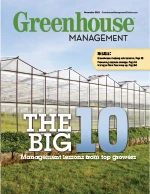 In recent months, fires raged across Washington state, and in June, 11 large wildfires raged across the nation. By the middle of the month that number had doubled, and as it ended, 57 wildfires burned on.
In recent months, fires raged across Washington state, and in June, 11 large wildfires raged across the nation. By the middle of the month that number had doubled, and as it ended, 57 wildfires burned on.
Much of this habitat- and home-destroying heat blazed in the West, notably in Colorado, where several large wildfires charred more than 165,000 acres and destroyed more than 700 residences. Now, as lonely roads twist through bare, blackened earth and around skeleton trees, it’s hard to imagine the land flourishing green and fertile once more.
But efforts by organizations such as Northern Arizona University’s Research Greenhouse Complex are bringing life back to areas devastated by wildfires. The NAU complex — located in Flagstaff, Ariz., and comprised of eight 1,000-square-foot greenhouses — offers contract growing for large-scale restoration and research projects for public and nonprofit organizations throughout Arizona and the Southwest.
“Can you really restore an ecosystem to the way it was before a fire? Can you rebuild it? I don’t know the answer to that,” says Philip Patterson, complex production manager. “What I do know is that if we can get the foundation [plant] species established, then we have a shot that other things, the animals, might move back in.”
 NAU’s Research Greenhouse Complex was dedicated in 1988 with a mission to support universitywide research. For more than 20 years, it has been the site of studies in areas such as forestry, biology, chemistry and environmental sciences.
NAU’s Research Greenhouse Complex was dedicated in 1988 with a mission to support universitywide research. For more than 20 years, it has been the site of studies in areas such as forestry, biology, chemistry and environmental sciences.
Run by two full-time associates and one part-time associate, the complex’s research is conducted mainly by a rotation of undergraduate, master’s level, doctoral and post-doctoral students. Examples of current projects include research into the cottonwood genome and ways to control weeds without pesticides.
During recent years, it has expanded upon its research-centric mission to include growing plants for habitat restoration and developing partnerships with local, state and federal agencies that are involved with plant production for restoration.
Growing with a cause
The NAU Research Greenhouse Complex first engaged in post-wildfire restoration after the 2002 Rodeo-Chediski Fire burned more than 478,000 acres in Arizona’s White Mountains. At the request of nonprofit Trees for Rims, the complex began providing seedlings to restore affected private and municipal land.
“Over about a seven- to eight-year period, we ended up growing about 300,000 plants — from ponderosa pine seedlings, native grasses and shrubs to fire-wise plants,” Patterson says. “We also came up with an education program with the Arizona Tree Community Council and (Arizona) State Land Department to develop an education program, how to plant their trees, how to water their trees.”
The research greenhouse followed up on this success with another nonprofit restoration project, Trees for Mt. Lemmon, to help restore private land burned in the 2003 wildfire on Mt. Lemmon, outside of Tucson, Ariz. It has delivered 7,000 plants for this effort to date, and has worked on several more projects since.
To fuel its continued efforts to aid in reforestation efforts following wildfires, the greenhouse has set up a freezer seed bank to ensure access to a substantial stock of native seed when need arises. The seed initiative focuses mainly on the ponderosa pine, a hardy tree that grows on slopes in the Southwest.
“We live right smack-dab in the middle of the largest continuous ponderosa pine forest in the world,” Patterson says. “It is the species. … The ponderosa pine is the tree that did grow (in these affected areas), it still grows nearby there, so it makes sense to try and regrow those stands.”
Regrowing stands is important as their roots along steep slopes prevent erosion, flooding and mudslides. The pine also serves as the foundation species for other plants and animals.
“The whole ecosystem — from insects, birds, mammals, reptiles — all are based on that one, over story-type tree, with the associated plants with it,” Patterson says.
The NAU complex provides property owners with a newer planting plan for the ponderosa pines — clumps of trees separated by clear areas — to ensure a more natural, fire-retardant type of a stand.
“But it’s going to take a couple of generations to look like it did when you bought your property,” Patterson says of the long process needed to heal the land.
How you can help
Greenhouse managers who are interested in aiding in reforestation efforts or community outreach initiatives should take advantage of local resources, such as their local branch of the U.S. Forest Service.
 The NAU Research Greenhouse has expanded upon its research centric-mission to include growing plants for habitat restoration. The NAU Research Greenhouse has expanded upon its research centric-mission to include growing plants for habitat restoration. |
“Storing seed, you don’t need a huge area,” Patterson says of reforestation efforts. “You need a couple freezers. It’s a doable thing and it’s important.”
Having local seeds and the means and/or knowledge to grow them is especially key to reviving an area that’s been affected by fire, as seeds vary by region.
“If we have a fire in Flagstaff, we have ponderosa pine seed collected at that elevation in Flagstaff, and we’d plant the same seed there,” Patterson says. “If we planted some ponderosa pine seed from Colorado, it’s not adapted to that site.”
If you’re looking for information, NAU greenhouse is willing to assist as well.
He says, “We would love to help and partner, and we would love to give our [experience]. I’m more than willing to talk about the mistakes that we’ve made and what we’ve learned.”
|
Engaging the community The NAU Research Greenhouse engages its community in volunteer efforts for its reforestation initiatives, but also goes beyond the call of research duty to engage them about their own plant-growing needs. Education is an important initiative because Flagstaff only has a growing season of about 100 days maximum. “Everybody wants to have a greenhouse in their backyard,” says Philip Patterson, complex production manager. “We have people walking in off the street, saying, ‘Tell me, what kind of greenhouse should I have in my backyard?’ or other programs, people get together and say, ‘Let’s start growing vegetables in Flagstaff in a greenhouse.’ And I try to walk them back just a little bit on the business model of that. “It’s very expensive to run a greenhouse like we run it, but we have a fairly high-valued project with research. A tomato is a great thing to eat, but it’s not necessarily a high-valued product when just south of here, people can growth them pretty much 10 months out of the year outside.” Last year, the complex partnered with Local FARE, a campus sustainability project, to promote education on season-extending methods and food growing in Northern Arizona. A key method Patterson promotes for short-season areas is a cold frame greenhouse — an unheated, low-to-the-ground box with a transparent top that is useful for growing vegetables and home gardening. The NAU greenhouse’s education efforts extend to Ponderosa High School students, as well, who visit its greenhouses to observe and work on small projects. |
Jessica Hanna is a Cleveland-based freelance writer and frequent contributor for Greenhouse Management.

Do you know someone that has made a positive impact in the horticulture industry? Nominate them for a Horticultural Industries Leadership Award (HILA)!
| SUBMIT NOMINATION |

Explore the November 2012 Issue
Check out more from this issue and find your next story to read.
Latest from Greenhouse Management
- Meet the Next Gen: Gabriella Blair, Star Roses and Plants
- Leading Women of Horticulture: Katie Dubow, Garden Media Group, and Aubry Field, Lizzy Blossom
- Showing up at your horticulture business as your whole self
- Leading women of Greenhouse Management
- USDA fires experts on invasive pests, including Asian citrus psyllid, chilli thrips
- Farwest Show calls for 2025 New Varieties Showcase entries
- Leading Women of Horticulture: Arden Pontasch, North Creek Nurseries
- Leading Women of Horticulture: Emily Showalter, Willoway Nurseries






